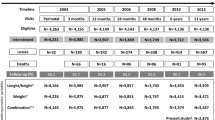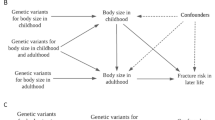Abstract
Summary
The incidence of hip fracture was estimated in 6,370 women born in Helsinki between 1934 and 1944. Women in the lowest quarter of adiposity gain had an 8.2-fold increase in hip fracture risk compared with those in the highest quarter (p < 0.001). These data point to a relationship between childhood growth and fracture risk during later life.
Introduction
Previous findings show that discordance between childhood increase in height and weight is associated with an increased risk of osteoporotic fractures during later life.
Methods
We studied 6,370 women born in Helsinki between 1934 and 1944. Each woman’s birth weight and length at birth was recorded, as well as her height and weight through childhood. We identified the occurrence of hip fracture through the National Finnish Hospital discharge register.
Results
There were 49 hip fractures in the 6,370 women over 187,238 person-years of follow-up. Hip fracture was associated with increasing Z-scores for height between 1 and 12 years, not matched by a corresponding increase in weight. Therefore, reduction in the Z-score for body mass index was associated with increased risk of hip fracture. Women in the lowest quarter of change in Z-scores for body mass index had an 8.2-fold increase in hip fracture risk (95% CI 1.9 to 35), compared with those in the highest quarter (p < 0.001).
Conclusion
Thinness in childhood is a risk factor for hip fracture in later life. This could be a direct effect of low fat mass on bone mineralization, or represent the influence of altered timing of pubertal maturation.

Similar content being viewed by others
References
Johnell O, Kanis JA (2006) An estimate of the worldwide prevalence and disability associated with osteoporotic fractures. Osteoporosis Int 17:1726–1733
Johansen A, Stone M (2000) The cost of treating osteoporotic fractures in the United Kingdom female population. Osteoporosis Int 11:551–552
Cooper C, Campion G, Melton LJ (1992) Hip fractures in the elderly: a world-wide projection. Osteoporosis Int 2:285–289
Cummings SR, Black DM, Nevitt MC, Browner WS, Cauley JA, Genant HK, Mascioli SR, Scott JC, Seeley DG, Steiger P (1990) Appendicular bone density and age predict hip fracture in women. The Study of Osteoporotic Fractures Research Group. JAMA 263:665–668
Seeman E, Hopper JL, Bach LA, Cooper ME, Parkinson E, McKay J, Jerums G (1989) Reduced bone mass in daughters of women with osteoporosis. N Engl J Med 320:554–558
Ferrari S, Rizzoli R, Slosman D, Bonjour JP (1998) Familial resemblance for bone mineral mass is expressed before puberty. J Clin Endocrinol Metab 83:358–361
Chevalley T, Rizzoli R, Hans D, Ferrari S, Bonjour JP (2005) Interaction between calcium intake and menarcheal age on bone mass gain: an eight-year follow-up study from prepuberty to postmenarche. J Clin Endocrinol Metab 90:44–51
Specker B, Binkley T (2003) Randomized trial of physical activity and calcium supplementation on bone mineral content in 3- to 5-year-old children. J Bone Miner Res 18:885–892
Specker BL (2003) Role of physical activity on bone mineral content in young children. J Musculoskelet Neuronal Interact 3:338–340
Godfrey K, Walker-Bone K, Robinson S, Taylor P, Shore S, Wheeler T, Cooper C (2001) Neonatal bone mass: influence of parental birthweight, maternal smoking, body composition, and activity during pregnancy. J Bone Miner Res 16:1694–1703
Javaid MK, Crozier SR, Harvey NC, Gale CR, Dennison EM, Boucher BJ, Arden NK, Godfrey KM, Cooper C (2006) Maternal vitamin D status during pregnancy and childhood bone mass at age 9 years: a longitudinal study. Lancet 367:36–43
Cooper C, Eriksson JG, Forsén T, Osmond C, Tuomilehto J, Barker DJP (2001) Maternal height, childhood growth and risk of hip fracture in later life: a longitudinal study. Osteoporosis Int 12:623–629
Eriksson JG, Forsén T, Osmond C, Barker DJP (2001) Early growth and coronary heart disease in later life: longitudinal study. Br Med J 322:949–953
Royston P (1991) Constructing time-specific reference ranges. Stat Med 10:675–690
Eriksson J, Forsén T, Osmond C, Barker D (2003) Obesity from cradle to grave. Int J Obes Relat Metab Disord 27:722–727
Cooper C, Westlake S, Harvey N, Javaid K, Dennison E, Hanson M (2006) Review: developmental origins of osteoporotic fracture. Osteoporosis Int 17:337–347
Cooper C, Fall C, Egger P, Hobbs R, Eastell R, Barker D (1997) Growth in infancy and bone mass in later life. Ann Rheum Dis 56:17–21
Cooper C, Cawley M, Bhalla A, Egger P, Ring F, Morton L, Barker D (1995) Childhood growth, physical activity, and peak bone mass in women. J Bone Miner Res 10:940–947
Laitinen J, Kiukaanniemi K, Heikkinen J, Koiranen NP, Sovio U, Keinänen-Kiukaanniemi JMR (2005) Body size from birth to adulthood and bone mineral content and density at 31 years of age: results from the northern Finland 1966 birth cohort study. Osteoporosis Int 16:1417–1424
te Velde SJ, Twisk JWR, van Mechelen W, Kemper HCG (2004) Birth weight and musculoskeletal health in 36-year-old men and women: results from the Amsterdam Growth and Health Longitudinal Study. Osteoporos Int 15:382–388
Jones G, Dwyer T (2000) Birth weight, birth length, and bone density in prepubertal children: evidence for an association that may be mediated by genetic factors. Calcif Tissue Int 67:304–308
Fewtrell MS, Cole TJ, Bishop NJ, Lucas A (2000) Neonatal factors predicting childhood height in preterm infants: evidence for a persisting effect of early metabolic bone disease? J Pediatr 137:668–673
Javaid MK, Lekamwasam S, Clark J, Dennison EM, Syddall HE, Loveridge N, Reeve J, Beck TJ, Hertfordshire Cohort Study Group (2006) Infant growth influences proximal femoral geometry in adulthood. J Bone Miner Res 21:508–512
Wells JC, Coward WA, Cole TJ, Davies PS (2002) The contribution of fat and fat-free tissue to body mass index in contemporary children and the reference child. Int J Obes Relat Metab Disord 26:1323–1328
Ylihärsilä H, Kajantie E, Osmond C, Forsén T, Barker DJP, Eriksson JG (2008) Body mass index during childhood and adult body composition in men and women aged 56 to 70 years. Am J Clin Nutr 87:1769–1775
Petit MA, Beck TJ, Lin HM, Bentley C, Legro RS, Lloyd T (2004) Femoral bone structural geometry adapts to mechanical loading and is influenced by sex steroids: the Penn State Young Women's Health Study. Bone 35:750–759
Oliver H, Jameson KA, Sayer AA, Cooper C, Dennison EM, Hertfordshire Cohort Study Group (2007) Growth in early life predicts bone strength in late adulthood: The Hertfordshire Cohort Study. Bone 41:400–405
Piirtola M, Vahlberg T, Isoaho R, Aarnio P, Kivelä SL (2007) Incidence of fractures and changes over time among the aged in a Finnish municipality: a population-based 12-year follow-up. Aging Clin Exp Res 4:269–276
Karlberg J (1989) A biologically-oriented mathematical model (ICP) for human growth. Acta Paediatr Scand 350(Suppl):70–94
Mackey DC, Lui LY, Cawthon PM, Bauer DC, Nevitt MC, Cauley JA, Hillier TA et al (2007) High trauma fractures and low bone mineral density in older women and men. JAMA 298:2381–2388
Acknowledgements
The study was supported by grants from the Medical Research Council of Great Britain, the Academy of Finland, British Heart Foundation, Finnish Diabetes Foundation, Finnish Foundation for Cardiovascular Research, Finnish Medical Society Duodecim, Finska Läkaresällskapet, Foundation for Pediatric Research, Jalmari and Rauha Ahokas Foundation, Juho Vainio Foundation, Novo Nordisk Foundation, Päivikki and Sakari Sohlberg Foundation, Signe and Ane Gyllenberg Foundation, Yrjö Jahnsson Foundation and the NIHR BRU, University of Oxford.
Conflicts of interest
None.
Author information
Authors and Affiliations
Corresponding author
Rights and permissions
About this article
Cite this article
Javaid, M.K., Eriksson, J.G., Kajantie, E. et al. Growth in childhood predicts hip fracture risk in later life. Osteoporos Int 22, 69–73 (2011). https://doi.org/10.1007/s00198-010-1224-3
Received:
Accepted:
Published:
Issue Date:
DOI: https://doi.org/10.1007/s00198-010-1224-3




